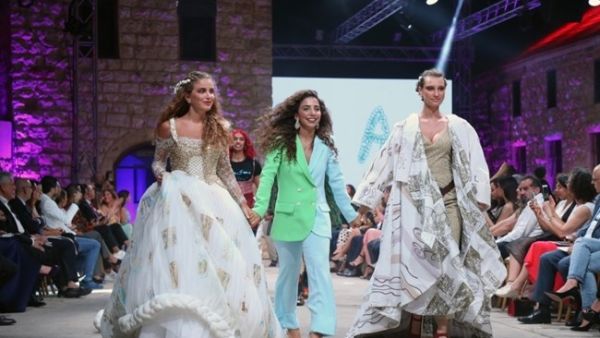Candles, blue lights and moving white spotlights set the mood for the third annual fashion show put on by the Lebanese American University’s fashion school.
Taking place at La Magnanerie, a reconstructed 19th-century silk factory in the Metn area just outside Beirut, the event showcased the work of 13 students presenting 10 pieces each to a jury that included designer Elie Saab, the program’s honorary chair.
The show highlighted the work of the school’s third graduating class, and was held in collaboration with the London College of Fashion.
Saab and Joseph Jabbra, LAU’s president, said the program, founded in 2013, was established with the hopes of benefiting Lebanese students in the long run.
Jabbra’s message to the graduates: “Don’t be scared of anything. The world is waiting for you.”
Many of the designers produced collections that pushed boundaries through their use of different materials and techniques, and unique colors. Among them was Mickaella Nassar, whose “Marie Noel” collection made a personal fashion statement that had attendees taken aback. Inspired her mother, who passed away when Nassar was young, the collection included pieces portraying various phases in her mother’s life.
Not just the subject matter but also the use of materials brought the designer out of her comfort zone. LED lights, stone, 3D shapes inspired by her mother’s work during her college years as an interior architect - Nassar worked all these nontraditional materials into her work.
In one piece, Nassar honored her late mother with a long, white cape that had her mother’s portrait on the back, in sand-colored ceramic stones. Another piece, a wedding dress, seemed to pay tribute to her mother’s wedding day.
“The entire program was built to motivate the youth to stay and excel in Lebanon,” Saab told The Daily Star. He said he believed the program encouraged the students to hone their skills in their country before branching out internationally.
“It’s a graduate runway show, not a student fashion show,” said Jason Steel, who has coordinated the show all three years. Steel told The Daily Star he believed that the students should challenge themselves to create daring designs and be outsiders.
He said the first year of the event had paved the way, while the second pushed the boundaries. He said this year’s edition hadn’t been easy, and that the students found it challenging to push things further forward.
His advice to them was to “be who you are, not who you think you should be,” to push the boundaries.
Some seemed to have taken this advice to heart, including in their collections a variety of designs that tackled complex social issues such as gender and sexuality, identity, cultural diversity and faith backgrounds.
A collection by another graduating designer, Ghenwa Al Alam, was titled “Art et Force,” and took inspiration from circus life.
The designer said she challenged herself by using a lot of pink.
“I love pink and I’m not afraid to use it,” she said.
{"preview_thumbnail":"https://cdn.flowplayer.com/6684a05f-6468-4ecd-87d5-a748773282a3/i/v-i-3…","video_id":"3ab0b5ce-2b72-42ed-be96-322f17fdf3e4","player_id":"8ca46225-42a2-4245-9c20-7850ae937431","provider":"flowplayer","video":"US Unveils 'Deal of the Century' as Normalisation of Israeli Occupation"}
Her clothes featured fun and bright shades alongside a mix of other colors like yellow, which bolstered designs that ranged from outwardly simple to boundary-pushing. One eye-catching dress was made from a puffy material, while a simple pink overall was matched with a bag and heels.
Celine Dagher took the audience back to the 1970s with a collection of dark clothing that challenged looks traditionally considered feminine. “It’s About Time” incorporated elements associated with the ’70s to highlight the idea that people shouldn’t have to dress according to the era they are living in.
“Fashion is about personalities and personal expression,” Dagher told The Daily Star.
The designer used bedazzled fire drawings on many of her pieces, giving a different turn to feminine attire. She balanced this with a dark color scale and limited color palate, creating a rock’n’roll look that gave her collection a distinctively modern flare.
Tanya El Skaf included plastic squares into her pieces.
For one design, a wedding dress, she used an older woman as a model instead of a young one.
Jihane El Semrany, by contrast, stayed closer to modern fashion by using iridescent colors, taking inspiration from the dynamic shift from “old” to “modern” Lebanon.
Philippe El Riachi upcycled objects and used zero-waste pattern drafting to create his designs.
He created a tribal collection inspired by four different tribes, and his design choices were unique in terms of craftsmanship.
His revealing clothing caused chatter among the crowd.
At the show’s end, awards were presented to three graduating students: Jana Abou Zahra took home the Prix du Jury, while Semrany won the Concept and Portfolio Award and Therese Raffoul received the prize for Excellence and Craftsmanship.
Saab and Jabbra said they applauded all the students’ work.
Saab acknowledged the graduating class for the uniqueness and enthusiasm that its members projected on to their work, while Jabbra said he was proud of them.
This article has been adapted from its original source.








